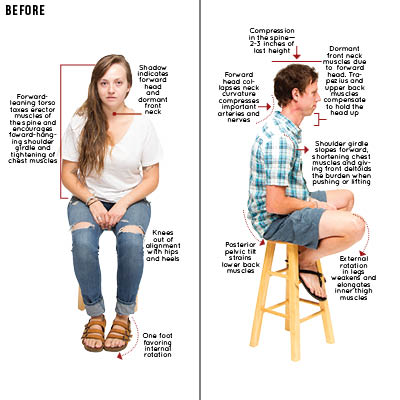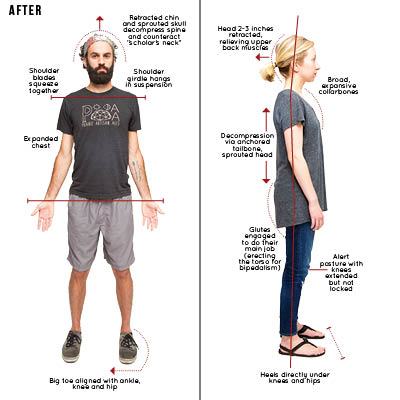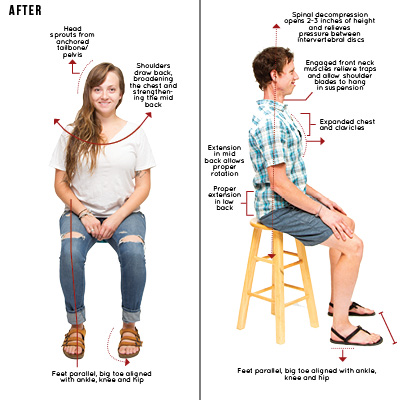Straighten up
Posture and health profile go hand in hand
Jake Miller (Brewer at Prairie Artisan Ales, gardener, bookworm, fish conservationist) and Georgia Brooks (Graphic designer and illustrator at The Tulsa Voice, multi-activity dabbler, dedicated TV watcher, lover of socks)
Michelle Pollard
As a kid, I constantly heard my mom tell me to “Sit up straight!” She actually had a cue I still use occasionally: Pretend there’s a string attached to the crown of your head that’s being pulled upward. I’d lift my head when she would insist, but when she looked away, I’d forget and collapse back into compression.
Obsessively readjusting your spine in resting positions won’t solve your posture problems, but it’s one piece of the puzzle (arguably the smallest). Our structures are built for adaptive and complex movement sequences. It’s how we got honey from beehives, took down game with handcrafted weaponry and built dynamic, durable shelters. Though life for many of us looks a lot different now, we’ve still got all that natural potential. So how can we make the most of it?
When it comes to posture and movement, keep five basics in mind:
- physical environment
- infant motor development
- psychosocial factors
- breathing
- biomechanical alignment
Degeneration in one of these areas affects all others, and the cycle does a number on us: compressed spines, forward tilting heads, nonexistent spinal rotation, flabby butts, flat arches and the list goes on. If your self-image is taking a hit right now, take a deep breath. I teach this stuff daily but can frequently be spotted with a Disney-film-worthy hunch in my thoracic spine.
So, the teacher can’t even stand up straight—what’s the point? Think about how many years you’ve caved into your computer screen, toughed it out in high heels, sat in traffic, slept on cushy surfaces and complied with the “comfortable,” low-energy-expenditure modern lifestyle—15 years? 24 years? 65 years? Nothing adapts overnight, and ridding your life of every trigger is nearly impossible. Instead, go easy on yourself as you gradually adopt practices that better serve you.

THE FISHBOWL EFFECT
For roughly 150,000 years, humans lived in open spaces as nomads, hunters and gatherers and evolved to assume an endless array of body positions. Urban lifestyles often find us boxed in and unable to move freely, stand tall, play and encounter the unpredictable (which inspires improvisation—a necessity for building functional movement patterns). That’s one reason it feels so good to get outside—this is where our expansive animalistic postures reawaken.
Go outside and freely experiment with natural movement patterns like climbing, crawling, jumping, balancing and laughing. Open your chest, breathe deeply and rotate your spine. You’ll reap the benefits of evolution by moving with your design instead of against it.
ACTING AGELESS
Most kids move through a natural motor development process involving establishment of head control, rolling patterns, balanced sitting, crawling, and bipedal ambulation (walking upright). Chiropractor and functional movement specialist Dr. Andreo Spina writes that parents should allow kids to explore movement at their own pace, as they’re still in tune with natural progressions.
This stuff is so important that there are fitness regimens for adults to reawaken their childhood movement. Original Strength, founded by kettle-bell instructor Geoff Neupert and restorative exercise specialist Tim Anderson, encourages adults to move like babies. Rocking, rolling, smiling and dancing are all part of promoting postural improvements and movement returns in adults dealing with long-term imbalances.
 MIND AND MATTER
MIND AND MATTER
Research by Harvard psychologist Amy Cuddy suggests that posture affects emotional and hormonal balance and vice versa. Guarded, small postures decrease testosterone, increase the stress hormone cortisol, lower confidence and make us unlikely to take risks.
In Cuddy’s TED talk, she encourages more powerful and expansive poses, which position us for greater wellbeing and prosperity.
For a humorous but relatable cue, I instruct many of my clients to walk tall and rotate their shoulders with a bit of “swagger.” They typically laugh and assume amazing posture instantly but feel self-conscious about it. I’ve observed that holding my body this way reduces anxiety, improves confidence and enriches my vocal tone. I’ve also noticed that my interactions are more positive and productive when I carry myself expansively, with soft eyes and a gentle smile. It’s contagious; try it, and watch your friends’ mirror neurons engage. Before you know it, everyone in the room will appear taller, happier and more at ease.
 DON’T HOLD YOUR BREATH
DON’T HOLD YOUR BREATH
When was the last time you took a deep, diaphragmatic breath? I can guarantee it wasn’t when you got cut off on 169 South yesterday. The diaphragm connects to the sternum, ribs and vertebrae. At full expansion, this muscle creates space for the intervertebral discs of the spine. When stress is high, breathing tends to become shallow, leaving our lower lungs and ribs dormant. At least for me, it doesn’t take much to activate a fight-or-flight response: driving a motor vehicle, deadlines, calls from disgruntled family members and sober concerts, to name just a few.
Try this exercise: Take a breath deep into the lower abdomen and exhale all the way with intensity. It will probably feel extremely foreign, but breathing in this way helps decompress and mobilize vertebrae, strengthen the core and make spinal rotations safer.
BEYOND COMFORTABLE
So what is proper alignment? To get an idea, stand tall and keep the outsides of your feet parallel. Unlock your knees and flex your butt muscles. Pretend you’re standing on a block of ice, and anchor your lower body. Sprout your head as high as possible, as if you were trying to see over a fence, and expose the chest, feeling the opening in your collarbones. Now, brace your abdomen as if someone were about to jab you in the stomach, and breathe behind this shield. Lastly, lean back, moving only the ankle joints, until you feel the front of your neck light up.
Because you’ve spent your whole life straying from this vital position, this will probably feel extremely uncomfortable. I know it’s a lot; don’t give up. As long as your diaphragm is working, your spine is long and strong and you’re moving with a sense of play, you’re on the right track. Fitness isn’t defined by hours on a treadmill, and healthy posture doesn’t come from standing up straight while waiting in long lines. The human body is pretty good at sitting, driving and texting, but it is best at climbing trees, dancing with friends and moving without restrictions.
For more from Zac, read about the popularization of the squat, why those tight yoga pants are bad for your health and reasons to show a little more skin.


.jpg)
.jpg)
